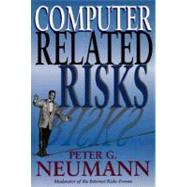
What is included with this book?
About Peter Neumann
Peter G. Neumann (Principal Scientist in the Computer Science Laboratory of SRI International) runs the popular and provocative on-line Internet newsgroup, The Risks Forum, which he started in 1985. He also writes the widely read "Inside Risks" column in the Communications of the ACM. Running RISKS is a sideline to his research and development interests, which include computer hardware and software, systems, networks, and communications, as well as security, reliability, and safety--and how to attain them. He is a Fellow of both the ACM and the IEEE. He is often the first person called when computer disasters occur.
020155805XAB04062001
| The Nature Of Risks | |
| Background on Risks | |
| Sources of Risks | |
| Adverse Effects | |
| Defensive Measures | |
| Guide to Summary Tables | |
| Reliability And Safety Problems | |
| Communication Systems | |
| Problems in Space | |
| Defense | |
| Civil Aviation | |
| Trains | |
| Ships | |
| Control-System Safety | |
| Robotics and Safety | |
| Medical Health and Safety | |
| Electrical Power | |
| Computer Calendar Clocks | |
| Computing Errors | |
| Security Vulnerabilities | |
| Security Vulnerabilities and Misuse Types | |
| Pest Programs and Deferred Effects | |
| Bypass of Intended Controls | |
| Resource Misuse | |
| Other Attack Methods | |
| Comparison of the Attack Methods | |
| Classical Security Vulnerabilities | |
| Avoidance of Security Vulnerabilities | |
| Causes And Effects | |
| Weak Links and Multiple Causes | |
| Accidental versus Intentional Causes | |
| Security And Integrity Problems | |
| Intentional Misuse | |
| Security Accidents | |
| Spoofs and Pranks | |
| Intentional Denials of Service | |
| Unintentional Denials of Service | |
| Financial Fraud by Computer | |
| Accidental Financial Losses | |
| Risks in Computer-Based Elections | |
| Jail Security | |
| Threats To Privacy And Well-Being | |
| Needs for Privacy Protection | |
| Privacy Violations | |
| Prevention of Privacy Abuses | |
| Annoyances in Life, Death, and Taxes | |
| What's in a Name? | |
| Use of Names as Identifiers | |
| A System-Oriented Perspective | |
| The Not-So-Accidental Holist: A System View | |
| Putting Your Best Interface Forward | |
| Distributed Systems | |
| Woes of System Development | |
| Modeling and Simulation | |
| Coping with Complexity | |
| Techniques for Increasing Reliability | |
| Techniques for Software Development | |
| Techniques for Increasing Security | |
| Risks in Risk Analysis | |
| Risks Considered Global(ly) | |
| A Human-Oriented Perspective | |
| The Human Element | |
| Trust in Computer-Related Systems and in People | |
| Computers, Ethics, and the Law | |
| Mixed Signals on Social Responsibility | |
| Group Dynamics | |
| Certification of Computer Professionals | |
| Implications And Conclusions | |
| Where to Place the Blame | |
| Expect the Unexpected! | |
| Avoidance of Weak Links | |
| Assessment of the Risks | |
| Assessment of the Feasibility of Avoiding Risks | |
| Risks in the Information Infrastructure | |
| Questions Concerning the NII | |
| Avoidance of Risks | |
| Assessment of the Future | |
| Table of Contents provided by Publisher. All Rights Reserved. |
The New copy of this book will include any supplemental materials advertised. Please check the title of the book to determine if it should include any access cards, study guides, lab manuals, CDs, etc.
The Used, Rental and eBook copies of this book are not guaranteed to include any supplemental materials. Typically, only the book itself is included. This is true even if the title states it includes any access cards, study guides, lab manuals, CDs, etc.